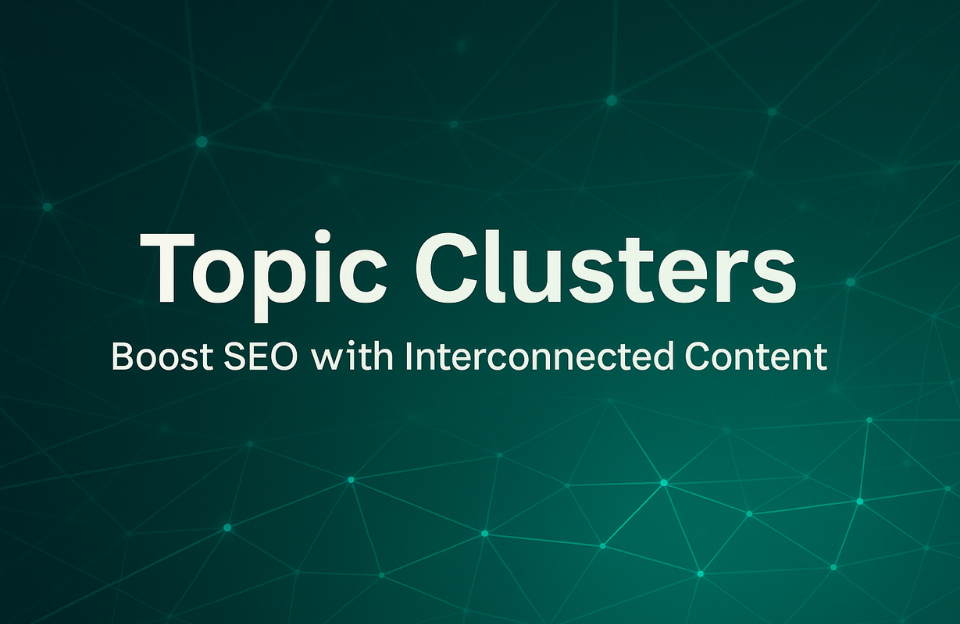Topic Clusters: Build Authority and AI-Relevance Through Interconnected Content
In an age where both readers and search engines crave clarity, depth, and structure, topic clusters have emerged as one of the most effective content strategies for SEO and AI optimization. But what exactly are topic clusters—and why should they be at the core of your content marketing approach?
What Are Topic Clusters?
A topic cluster is a content framework that revolves around one central theme—called a pillar page—supported by a group of related subtopics, or cluster content. Each cluster page links back to the main pillar and often to other related articles, creating a tightly interlinked network of pages.
Example:
- Pillar Page: “Email Marketing: The Complete Guide”
- Cluster Articles:
- “How to Build an Email List from Scratch”
- “Best Email Marketing Tools in 2025”
- “Email Segmentation Strategies for Higher Conversions”
- “A/B Testing for Email Campaigns”
Why Do Topic Clusters Matter?
1. Search Engines Understand Context
Google and other search engines use semantic relationships between pages to understand topical authority. Clusters show them that you’re not just publishing random content—you’re building a complete, structured knowledge base.
2. AI and LLMs Interpret Your Expertise
Language models and AI assistants (like Google’s SGE or ChatGPT) benefit from structured, interlinked content. Clusters provide the context that helps AI determine what your site is about and when to surface your answers.
3. Users Find Related Content Seamlessly
Internal linking through clusters keeps users engaged longer, reduces bounce rates, and improves session depth.
4. You Build Topical Authority
When you cover a subject from every angle and demonstrate depth, Google begins to view you as an authority—resulting in higher rankings for both short- and long-tail keywords.
How to Build an Effective Topic Cluster
🧱 Step 1: Identify Your Pillar Topic
Choose a broad, high-level topic with strong search potential that you want to be known for. It should be evergreen and valuable to your core audience.
🛰️ Step 2: Research Cluster Subtopics
Use tools like Semrush, Ahrefs, or AnswerThePublic to find long-tail queries, FAQs, and niche questions around your pillar. These will form your cluster articles.
🔗 Step 3: Strategically Interlink Pages
- All cluster pages should link to the pillar page.
- The pillar page should link out to every cluster article.
- When relevant, cluster pages can link to each other.
✍️ Step 4: Optimize for UX & SEO
- Use consistent formatting across your cluster pages.
- Maintain unique meta descriptions and title tags.
- Include CTAs and internal navigation prompts.
Pro Tip: Map Your Clusters Visually
Use a visual map or spreadsheet to keep track of:
- Published clusters
- Interlinking relationships
- Gaps in coverage
This ensures that your cluster remains cohesive and complete.
Common Pitfalls to Avoid
- ❌ Writing dozens of articles but failing to connect them
- ❌ Creating a pillar page that’s too shallow or keyword-stuffed
- ❌ Targeting loosely related topics that dilute your cluster focus
- ❌ Letting content go outdated without periodic updates
Bonus: Topic Clusters and AI Search
Topic clusters make your content AI-friendly in several ways:
- Structured clusters provide AI with contextual cues across multiple pages.
- Interlinking teaches LLMs how your content pieces relate—critical for featured snippets and voice search.
- When AI models evaluate topical coverage (as seen in SGE or Bing Chat), clusters help surface your content more reliably than isolated pages.
Conclusion
Topic clusters are no longer just an SEO tactic—they’re the backbone of content strategy in an AI-powered search world. By creating interconnected content around pillar topics, you serve both your human audience and the algorithms that guide them.
Whether you’re starting fresh or auditing your existing blog structure, think clusters, not chaos.




